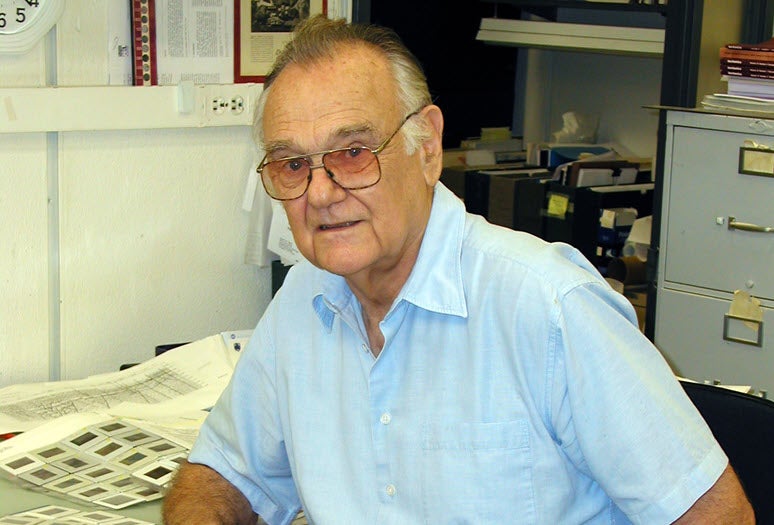Dear Alumni and Friends of the Earth, Environmental and Planetary Sciences department,
It is with great sadness that we must report that our beloved Bert Bally passed away this week. Bert joined Rice in 1981 as chairman of what was then the Department of Geology and Geophysics. He was appointed the Harry Carothers Wiess Professor of Geology, a position he held until he retired.
Born in The Hague, Netherlands, he spent his early years in Indonesia, Italy, and Switzerland. He began as a paleontologist at the University of Zurich and mapped in the Central Apennines for his Ph.D.
Prior to his tenure at Rice, he worked for Shell Oil where he rose through the ranks to become chief geologist. He would spend many summers mapping the Canadian Rocky Mountains and foothills of Alberta. Because of this, Bert recognized the importance of combining seismic reflection records with geologic maps to reconstruct the history of mountains and basins. One of his greatest and longest lasting contributions is his two three-volume sets of seismic atlases (1983) that popularized the use of industrial reflection techniques for scientific purposes. Until his death, he was considered the world’s leading expert in using seismic records to interpret regional geology, particularly in fold and thrust belts.
Bert had an amazing ability to synthesize regional geologic and geophysical data into a continental-scale framework. He made enduring contributions to the structure and orogenic evolution of the North American Cordillera by demonstrating how regional seismic data could be used to understand fold belts. This included outlining many of the principles for making balanced cross sections, and showing that the fold belts are underlain large decollements, and revealing the intimate relationship between foredeep subsidence with tectonic activity in the fold belt.
In 1990, along with two other Rice structural geologists, John Oldow and the late Hans Ave Lallemant, Bert recognized that there was a severe deep lithosphere mass balance problem in Cordilleran type orogens and was one of the first to suggest the importance of large-scale delamination before it became popularized in the early 2000s.
With T. Cook he published the Stratigraphic Atlas for North and Central America (1975), complete with more than 250 maps showing the entire Phanerozoic stratigraphy of North America.
As a counselor with the Geological Society of America, it was Bert who proposed the Decade of North American Geology (DNAG) project, a large multivolume encyclopedia on the geology of North America. To this day, the DNAG volumes represent the most comprehensive geologic study of a continent ever done.
More impressive than his scholastic achievements were the life-changing impacts he had on his students and anyone who had the fortune of interacting with him. His former students remember him as not just a scientific mentor but a mentor in life. His curiosity was never satiated. It was so contagious that when anyone was around him, everything seemed interesting. He was an encyclopedia of geology, having seen and read so much during his long and productive life. Faculty and students, whenever they wanted to explore a new area (of research or geography), did well to pick Bert’s brain. Going on a ride with Bert, however, meant that sometimes discussions would digress into stories of his life, such as being forced to watch Mussolini march by when he was a boy, or visiting Tibet as one of the first western geologists to enter China. Then it would turn back to some of his favorite unsolved science problems, one of them being the unconformity.
In recognition of his contributions, Bert received many honors, including the William Smith medal (Geological Society of London), the Gustav Steinmann Medal (Geologische Vereinigung), the Sidney Powers Medal from the AAPG, the OTC Career Contribution Award for Structural Geology and many others.
After retirement, Bert continued at full speed ahead. He engaged with the department, showing students how to look at geologic maps. He gave generously, among many things recently helping us secure a Neoproterozoic mylonitized diamictite slab that now graces an entire wall in the foyer of our department. At the time of his death he was in the final stages of preparing and converting his global geologic maps, with accompanying text, for digital publication with the American Association of Petroleum Geologists. Bert never stopped.
Cin-Ty Lee, 2019
A reception honoring Bert Bally will be held on Friday, October 11, 2019 at 4:00pm on the patio of the Keith-Wiess Geology building on Rice University’s campus.
*Some of the content above was taken from Manik Talwani’s citation for Bert’s SEG Commendation Award and various interviews with Bert Bally by Daniel Minisini.
More information can be found here: https://www.youtube.com/watch?v=KmfkMrNcU5Q
SEG citation: https://earthscience.rice.edu/directory/user/101/
Google Scholar: https://scholar.google.com/citations?user=8m9RxuEAAAAJ&hl=en&oi=ao
There will be a memorial service held by the Bally family at St. Vincent De Paul Catholic Church (6800 Buffalo Speedway, Houston, Texas 77025) on Wednesday, 28 August at 10:00 a.m.
In lieu of flowers the family requests donations be made in memory of Albert and Elaine Bally to St. Vincent de Paul Catholic Church.





